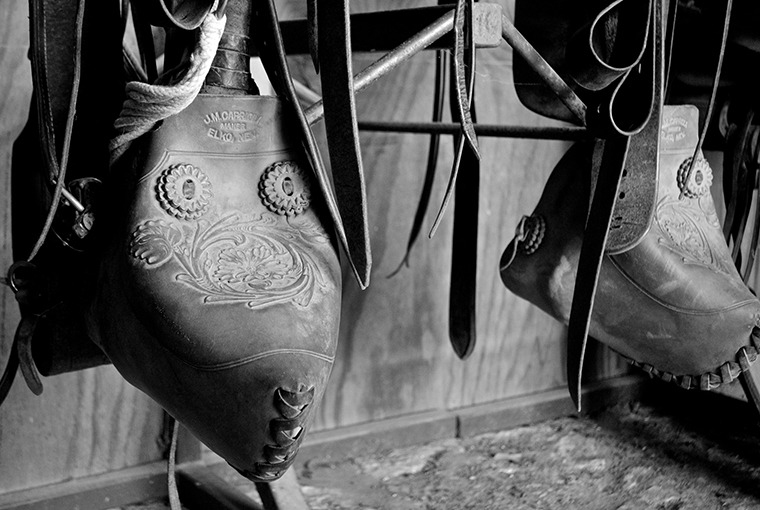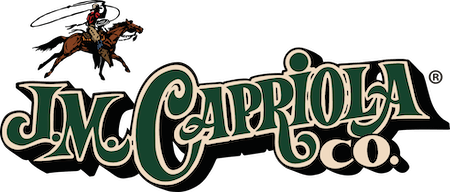My old pair of tapaderos remind me of a bone-chilling winter task.
By Kelli Neubert
February 11, 2016

Tapaderos protect a rider’s feet from brush and cold temperatures.
In the dark, dusty corner of a shelf in my tack room sits a hand-carved pair of bulldog tapaderos.
Tapaderos (also referred to as “taps”) are a specific style of stirrups. They have a hood-like covering over the front of the stirrup that prevents a rider’s boot from slipping through the entire stirrup and offers protection from brush, brambles and other thickets that he might encounter. They can also serve as a barrier for the rider’s feet against cold temperatures and harsh conditions.
For many, the thought of tapaderos may conjure up images of weathered vaqueros pushing cattle up the coast aboard their fine bridle horses. Perhaps you have more of a southwestern take and envision Texas brushpoppers with small rawhide taps, searching for strays in the mesquite. Either way, for most people they are a romantic part of the traditional stock saddle, and each region of cowboy has its own take on it. For me, the thought of tapaderos parallels with frozen fingers, a numb face and bitter, biting, Colorado cold. It is not a pleasant picture.
See, I received my taps as a gift years ago during my first winter at my northeast Colorado quarters. I was green as grass going into my new line of work, but very enthusiastic about learning. Being from California, I hadn’t spent an uncomfortable winter outside, much less a below-zero, snow-blowing-sideways winter. The fellow that I worked with knew this about me, and had JM Capriolas make a pair of beautiful little bulldog (small) tapaderos to match my saddle. It seemed like a nice gift at the time. I hung them from my saddle with a secret pride and even volunteered to ride out and check the cattle tanks for ice the next morning.
I bundled up in my Carhartt browns, hit a trot on my roan colt and cheerfully spent the next hour and a half making a circle from trough to trough, chipping away at the brittle skiff of ice that covered each tank. I took satisfaction at the comfort and warmth that my new stirrups offered my boots against the chilly breeze. I was even proud that I got a good ride in on my young horse and knew he would just keep getting better for it.
I got back and gushed my appreciation for my new gear. I even offered to make “breaking ice” horseback my new morning job. My co-worker was more than happy about that arrangement and didn’t argue much.

A friend gave me my pair of JM Capriola tapaderos.
Well, time went on and winter grew harsher. My cute little trips around the pastures turned treacherous. The “skiff” of ice atop the water turned into a 5 inch thick monster than my hatchet could barely bust. The chilly breeze morphed into a miserable, lasting gale that bounced pellets of snow and sleet off of my wind-blown cheeks. And though my taps probably kept my feet warmer than if I hadn’t had them, my feet were blocks of ice and the novelty of my new tack had faded quickly.
I grew to hate my task. I think my horse hated it too. Sure, there were some crisp, beautiful mornings where the sunlight peeked out and bounced off the snow. But mostly? It was just wind, ice and my short-tempered, cold little self. I cussed Colorado. I cussed cows. I cussed my taps that got me into this mess.
One morning I had to run into town and outsourced my ice-breaking job to the other, more experienced employee. I tried not to look too excited when I asked him to perform the task. I told him where I kept the hatchet and then offered him my saddle, complete with taps, so he could keep his feet warm while he trotted out there.
He thanked me, but then said that he would probably just take the pickup.
THE PICKUP?! I didn’t even know the pickup was an option! I rode every morning and froze and shivered and jittered around the pastures when I could have just driven the PICKUP, with a heater and radio?! I looked at him, jaw dropped, and said to him “You mean I could have driven the pickup to break ice instead of riding?! Why didn’t you tell me this?”
“Well,” he replied. “You never asked. Besides, you had those nice taps I gave you to keep your feet warm.”
I left for town, fuming, and when I got back home, I stripped the tapaderos off my saddle, stuck them in the corner of my tack room, and didn’t move them until I left the ranch.
Looking back, I realize that riding my horse morning after cold morning taught me many things—empathy, appreciation and knowledge (plus my colt did get more broke for it!). I’ve considered selling them, but I like having the reminder around of that time in my life. And who knows? Maybe one day I’ll have an employee of my own, one who’s eager to ride his colt in cold weather—and it would be a shame for him to let his feet get cold.
Article Courtesy of Western Horseman
Author- Kelli Neubert

